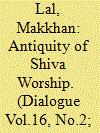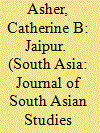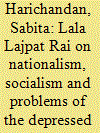|
|
|
Sort Order |
|
|
|
Items / Page
|
|
|
|
|
|
|
| Srl | Item |
| 1 |
ID:
135710


|
|
|
|
|
| Summary/Abstract |
India and China are not only the two oldest living civilizations in the world but still remain attached to their roots. Both the civilizations have seen, in the various stages of their existence, seven other Great Civilizations – Roman, Greek, Egyptian, Mesopotamian, Inca, Aztec and Maya – disappearing from the face of earth. By this simple fact one can understand the stability and all encompassing nature of both the civilizations – India and China. While the Chinese civilization continues from 1300 B.C. till date; the Indian civilization has continued with its ups and downs from 7th millennium B.C. – a time span of almost 9,000 years. Excavation of an Upper Palaeolithic shrine at the prehistoric site at Baghor, near Allahabad, and the similar shrine being in use today in the nearby village (see figs.1A and 1B) shows how the continuity, even in the shape of an abstract deity and the structure of shrine can survive almost over millennia.
|
|
|
|
|
|
|
|
|
|
|
|
|
|
|
|
| 2 |
ID:
137000


|
|
|
|
|
| Summary/Abstract |
This article is largely based on historical analysis of an overlooked and unexplored colonial document. The Sir James Clark Enquiry of 1868, conducted by the Government of India, contains rich evidence of the mindset of policymakers and those who implemented colonial psychiatry in 14 institutions. While the state regarded the asylum system as burdensome, it made ample efforts to sequester the insane. In view of such ambivalence, the article scrutinises the relationship between colonialism and psychiatry, and also probes some reasons behind the state’s inability to establish superior-quality asylums in India. The findings throw new light on the limited colonial agenda of psychiatry in India, highlighting the basically punitive nature of psychiatric infrastructures, linked with attempts to create an ordered society, but above all to minimise costs.
|
|
|
|
|
|
|
|
|
|
|
|
|
|
|
|
| 3 |
ID:
135835


|
|
|
|
|
| Summary/Abstract |
The collection of essays included in this issue of South Asia: Journal of South Asian Studies deals with a subject that, in the early months of 2014, commanded public attention on two counts: firstly, the decision of Penguin India to remove from sale and pulp Wendy Doniger's book, The Hindus: An Alternative History; and secondly, the appointment of Professor Y.S. Rao to the chairmanship of the Indian Council for Historical Research (ICHR). Both events are related in that they were immediately connected in the minds of interested parties with the anticipated and then achieved victory of the Bharatiya Janata Party (BJP) in the elections for the centre held in April and May 2014. Of these events, the first relates directly to the dissemination of scholarship in Social Sciences and Humanities as they apply to India, whereas the second concerns how this scholarship will be undertaken under the auspices of state funding. They are interrelated to the extent that they potentially embody a new paradigm in the study of Indian history and religion, one that could have implications outside India itself.
|
|
|
|
|
|
|
|
|
|
|
|
|
|
|
|
| 4 |
ID:
136850


|
|
|
|
|
| Summary/Abstract |
Subhas Chandra Bose is a name that shines with grandeur in the history of freedom movements of the world. He was a pole-star to the struggling million in India and abroad, who saw in him the bravest and the steadiest pilot to steer the patriotic expedition through the most tumultuous and hazardous seas of the significant international crisis, so far, to the heaven of freedom. He was one of the greatest patriots of contemporary India.
|
|
|
|
|
|
|
|
|
|
|
|
|
|
|
|
| 5 |
ID:
134262


|
|
|
|
|
| Summary/Abstract |
While Jaipur is commonly envisioned as a bastion for Hindus, this paper argues that the city, founded in 1727 by the Kachhwaha ruler, Sawai Jai Singh II, was intended to serve multiple populations. In many ways, ideologies behind Jaipur's development continue the Mughal emperor Akbar's policy of sulh-i kul, which loosely can be translated as universal toleration. Through an examination of Jaipur's architecture, built between the eighteenth and twentieth centuries, and paintings held in the court's royal collections, the city's growth and its diverse population can be seen as a map of state policy, which promoted tolerance to ensure good governance and prosperity.
|
|
|
|
|
|
|
|
|
|
|
|
|
|
|
|
| 6 |
ID:
135727


|
|
|
|
|
| Summary/Abstract |
Kashmir Shaivism, or the non-dual Shaivism of Kashmir as many scholars now prefer to call it, is a system of philosophy and theology rooted in the Tantric world view. What distinguishes it, is its idealistic outlook and monistic vision that conceives of the Ultimate Reality in terms of pure and undifferentiated consciousness vibrating in every atom of the universe. Describing consciousness as an all-pervasive principle that forms the ground and substratum of all existent things, Kashmir Shaivism regards the phenomenal world, with all its diversity, as its manifestation or expression. Man, according to this system of thought, is a contracted or congealed form of Parama Shiva or universal consciousness, the one and the only Reality. Realization of one’s true nature and self as one with Shiva liberates one from the tyranny of finitude. Rejecting the otherness of God, Kashmir Shaivism asserts that there is nothing that exists apart from or outside absolute consciousness.
|
|
|
|
|
|
|
|
|
|
|
|
|
|
|
|
| 7 |
ID:
135800


|
|
|
|
|
| Summary/Abstract |
This article analyses the Kosala movement in western Odisha in the light of a general model of sub-national movements in India. The popular agitation for a separate State has many of the ingredients of similar separatist movements in other parts of India. It draws on sentiments of discrimination and relative deprivation, for which the activists hold politicians from the more advanced coastal districts of Odisha responsible. Supporters of the movement point towards historical records of powerful kingdoms with all the ritual paraphenalia that go into the making of proto-states. Yet, the articulation of a strong sub-regional voice under the leadership of a political party comparable to the TRS in Telengana is absent. Detailed analysis reveals “Kosala identity” to lack cohesion. It is more a politically convenient label than a cohesive core capable of extracting the kind of sacrifice from participants. Finally, there are powerful countervailing, centripetal forces that act against the tendency towards separatism.
|
|
|
|
|
|
|
|
|
|
|
|
|
|
|
|
| 8 |
ID:
136838


|
|
|
|
|
| Summary/Abstract |
Nineteenth century marks the dawn of a new era for India, for India’s destiny was about to change. This is also the time many freedom fighters who crusaded to end the depredating British rule and tirelessly worked towards severing the shackles of India’s servitude to Britain
|
|
|
|
|
|
|
|
|
|
|
|
|
|
|
|
| 9 |
ID:
136839


|
|
|
|
|
| Summary/Abstract |
As Gandhi succinctly put it, “it is impossible to think of a single movement in which Lalaji was not linked.” Mr. Oswal Garrison Villard, editor of “Nation” described Lalaji as a wise, brave and sound ambassador, a generous and modest interpreter of great races to American democracy and a profound student of human liberties. Lala Lajpat Rai, Sher-i-Punjab was indeed, a lion both in thoughts and deeds . Contemporary relevance of his thoughts and prescriptions to remove anomalies from Indian society and polity deserve mention.
|
|
|
|
|
|
|
|
|
|
|
|
|
|
|
|
| 10 |
ID:
135827


|
|
|
|
|
| Summary/Abstract |
Naṭaṉa Gopāla Nāyaki Svāmikaḷ (1843–1914), born Ramabadran, was a Vaiṣṇava poet, mystic and performer who belonged to the Saurashtra community of Madurai. Revered within his community as the ‘Saurashtra Āḻvār’ (poet-saint), he is arguably their most important literary and musical figure. Initially known only to his intimate circle of family, as Nāyaki Svāmikaḷ's fame spread, his simple devotional compositions (kīrttaṉai) written in Tamil and Saurashtra are purported to have attracted disciples from all classes and castes in Madurai. Today, Nāyaki Svāmikaḷ's fame is largely confined to the Saurashtra community of Madurai, although the annual celebration in December of his samādhi (death, final liberation) brings together both the Tamil and Saurashtra communities of Madurai. The samādhi (sacred sepulchre) just outside Madurai is the primary locus for his worship, where he is remembered through the daily performance of his kīrttaṉais. In this paper, I trace the making of a twentieth-century Hindu saint within a small, but visible, migrant minority community in South India along the intersecting vectors of his hagiography and the circulation and performance of his Tamil and Saurashtri kīrttaṉais. I argue that Nāyaki Svāmikaḷ's hagiography and music bring together the Saurashtra community of Madurai, while simultaneously seeking to broaden his appeal outside the spatial confines of Madurai.
|
|
|
|
|
|
|
|
|
|
|
|
|
|
|
|
| 11 |
ID:
135799


|
|
|
|
|
| Summary/Abstract |
The leading industrial state in India, Maharashtra, is widely seen as a region with a cohesive political identity. My article focuses on the complex, shifting collective memories of Maratha history centered on the heroic figure of the seventeenth-century warrior-king Shivaji Bhosale, and the role they have played in the fabrication/fragmentation of regional identity. The first section charts the historical discourses anchored in various perceptions of caste, class, religion, and nation, which contributed to the emergence of a seemingly consensual construct of Shivaji as a key axis of regional identity. The second delves into the state’s cultural politics during the last five decades and highlights certain dramatic episodes that were triggered by supposed slights to the hallowed memory of the Maratha king. The third section provides an analysis of these episodes and reveals the contested character of regional identity in contemporary Maharashtra, which is driven by deep-seated antagonism between different communities.
|
|
|
|
|
|
|
|
|
|
|
|
|
|
|
|
| 12 |
ID:
136855


|
|
|
|
|
| Summary/Abstract |
Subhas Chandra Bose, popularly known as Netaji, occupied a unique position in the political scene of pre-independent India because of his distinctive political methods and strategic thinking. Ever since he appeared on the political scene of India, his courage, conviction, personality, patriotism, and sacrifice made him an icon for the people, especially the youth of the country. Though he believed in the collective leadership of the Congress to lead the masses towards the goal of national emancipation, he refused to toe the Gandhian line of phase-wise political movement based on constructive programmers and the ideology of non-violence.
|
|
|
|
|
|
|
|
|
|
|
|
|
|
|
|
| 13 |
ID:
135726


|
|
|
|
|
| Summary/Abstract |
Siva, the lord the south
There is a popular prayer in Tamilnadu saying “Hail ye Siva the lord of Southern Country, the god who pervades all the Countries – “Ten Nadudaya Sivane Porri, Ennattavarkum iraiva porri.” South India is the land of Shiva not in any sectarian sense of the word, but as “the most auspicious of all.” Shiva also stands for “auspicious” from the time of the Vedas and is an all inclusive faith. It is also for the reason that the Lord seated beneath the banyan tree (ala-vrksha) is the Universal teacher as Dakshinâmurthi is the most favoured form in TN, which represents the “God of the south” or the south facing god. One of the ancient legend mentioned in a two thousand years of Tamil poetry mentions that the sage Agastya came to the south at the command of lord Siva and brought with him 18 families of Royal chiefs, settled them in Tamil Nadu, taught the Pandya king of Madurai Tamil and Sanskrit, and also
music and dance. Ever since, he is identified as an incarnation of lord Shiva. That led to the translation of the Mahabharata into Tamil and the Shaivism found in the Mahabharata is the one that is found established in Tamil land.
|
|
|
|
|
|
|
|
|
|
|
|
|
|
|
|
| 14 |
ID:
136854


|
|
|
|
|
| Summary/Abstract |
If the Indian freedom struggle is a book none can overlook to include a chapter on Subhash Chandra Bose; and, if, it’s an epic it will never be complete without a canto on him. He is popularly referred to as ‘Netajee’. His influence is such that even today people wonder whether he is still alive or not. He is such an invaluable ever-shining jewel of India that even several attempts to honour him with Bharat Ratna look dim before his splendid glory. Bose was one of the greatest leaders of ‘mother India’ who is also rated one among the greatest patriots of the world. He was a man of action, not a philosopher nor a theorist. His chief concern was to free Mother India from the alien’s yoke.
|
|
|
|
|
|
|
|
|
|
|
|
|
|
|
|
| 15 |
ID:
134264


|
|
|
|
|
| Summary/Abstract |
This essay explores the rich verbal- and visual-narrative repertoires constitutive of a ‘sense of place’ within the Urdu-language Khushtar Ramayan, highlighting some of the significant ways in which they converge with and diverge from other prominent textual and visual representations of the Ramayan during the late nineteenth and early twentieth centuries. The material history of Khushtar's work as a book is also traced in order to illuminate a number of important linkages and shifts from a ‘local’ courtly economy and ‘sense of place’ to an emergent, proto-national, print-commercial one.
|
|
|
|
|
|
|
|
|
|
|
|
|
|
|
|
|
|
|
|
|